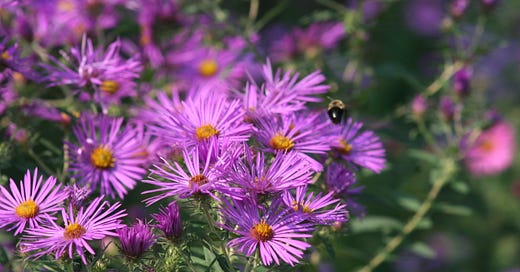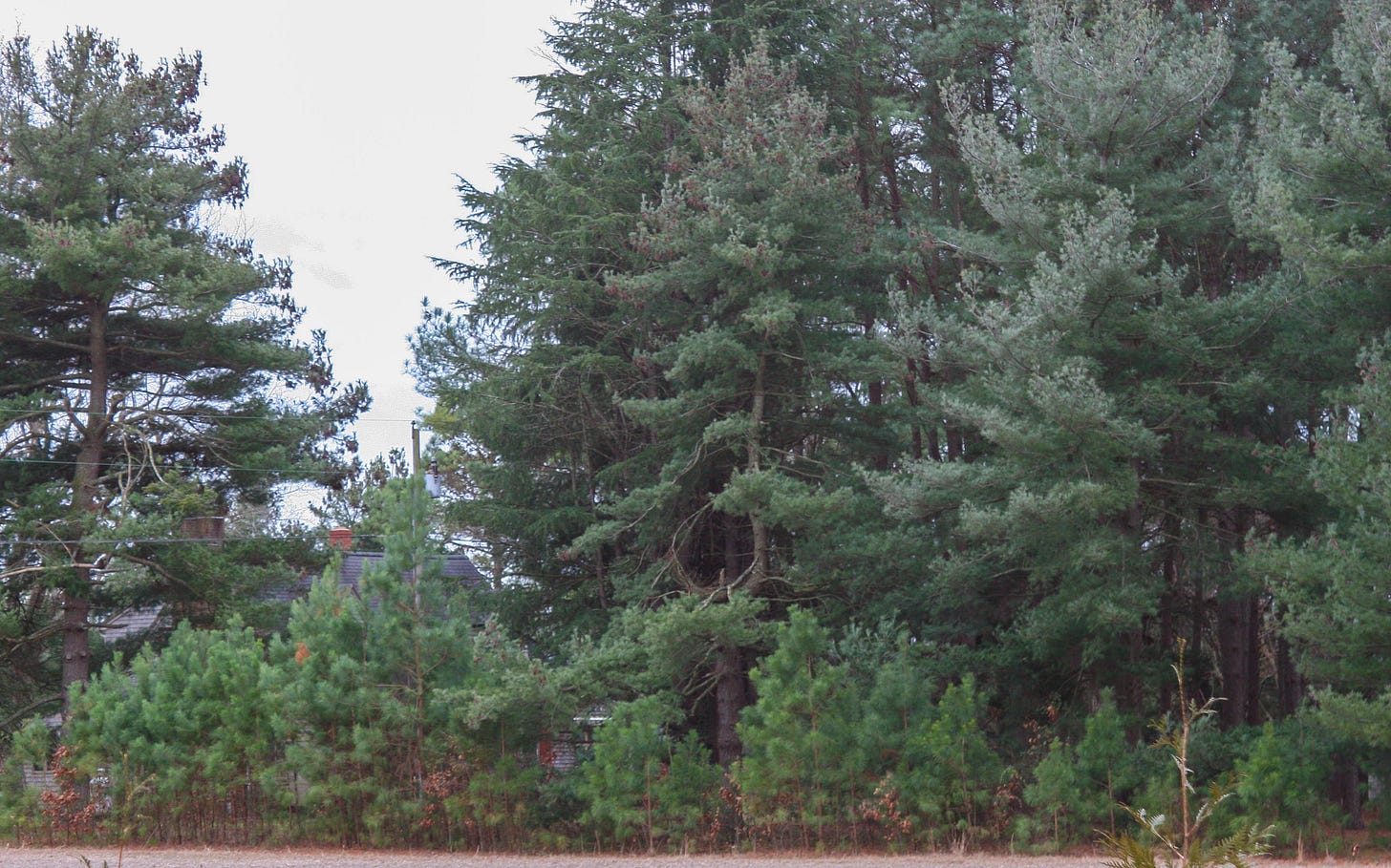Snow Days Are Planning Days
There’s no better time than NOW to get the jump on your spring plantings. The Natives you want to plant, of course. The many different trees, shrubs, ferns, grasses and wildflowers which you need to create the most wonderful, planet saving yard possible.
Go online, of course! Nurseries may or may not have what you’re looking for, so look online to grab the best of the best. They’ll ship to your location when it’s the proper temperature to plant, so right now, even with snow outside your windows, you can comfortably shop and know that when spring has sprung and you just can’t wait to be outside, you’ll get packages filled with life.
You may also want to call your local nurseries and ask them if they stock these plants - maybe you’ll encourage them to do so!
What to Look For
Evergreens
…if you don’t have some. There are many native pines, etc., that will bring birds by the dozens flocking to your yard. Beyond that, these are standouts for wildlife popularity and human viewers. While fall is arguably the best time to plant these treasures, early spring is also good - just remember to water them during dry spells. You can always mark your calendar to order later in the year for fall shipping.
American Holly (Ilex opaca) should be present in every yard! Native pretty much anywhere east of the Mississippi, this iconic Christmas-berries tree is a haven for birds in winters. The broadleaves create a marvelous windbreak and the berries are devoured by hungry birds in the winter (the flowers in spring are a bonanza for pollinators). It can be easily pruned into almost any shape.
Sweetbay Magnolia (Magnolia virginiana) is as great for wildlife as it is to its human viewers. Birds feed on its seeds. Some also use the leaves for nest construction!
Eastern Red Cedar (Juniperus virginiana). Lovely year round, the berry-like cones feed birds, especially in winter.
Shrubs
Shrubs are easily the most overlooked element of Granny’s Garden, yet they, all by themselves, can provide you a yard full of delighted pollinators and birds. Shrubs don’t have to be evergreen to be incredibly useful! Shrubs in leaf provide nesting and roosting spots for birds; in flower, they provide a cornucopia of pollen and nectar for pollinators; and, in winter, even without leaves, provide “winter interest” and a resting spot for busy birds. Many are larval host plants for butterflies, moths, and other fine creatures. Here are a few standout natives that will flourish in all but the deepest shade:
Chokeberry - Aronia arbutifolia. Once you have this shrub you will wonder that you don’t see it everywhere. Growing to a maximum of 8 ft., spreading 3-4 ft., it is easily pruned to smaller size. Its April blooms bring joy to pollinators; the dark green leaves give cover for birds; in fall, orange/red replaces the green of the leaves, and charming, red, bird feeding fruit appears. Even the bark is attractive, providing winter interest. Larval host plant to Zebra Swallowtail butterfly!
New Jersey Tea - Ceanothus americanus. Actually prefers dry, rocky soil. White blooms in early summer are a boon to pollinators, it’s a great larval host for several butterflies, and its short stature - maximum 4 ft. - allows it to comfortably settle into almost any garden setting.
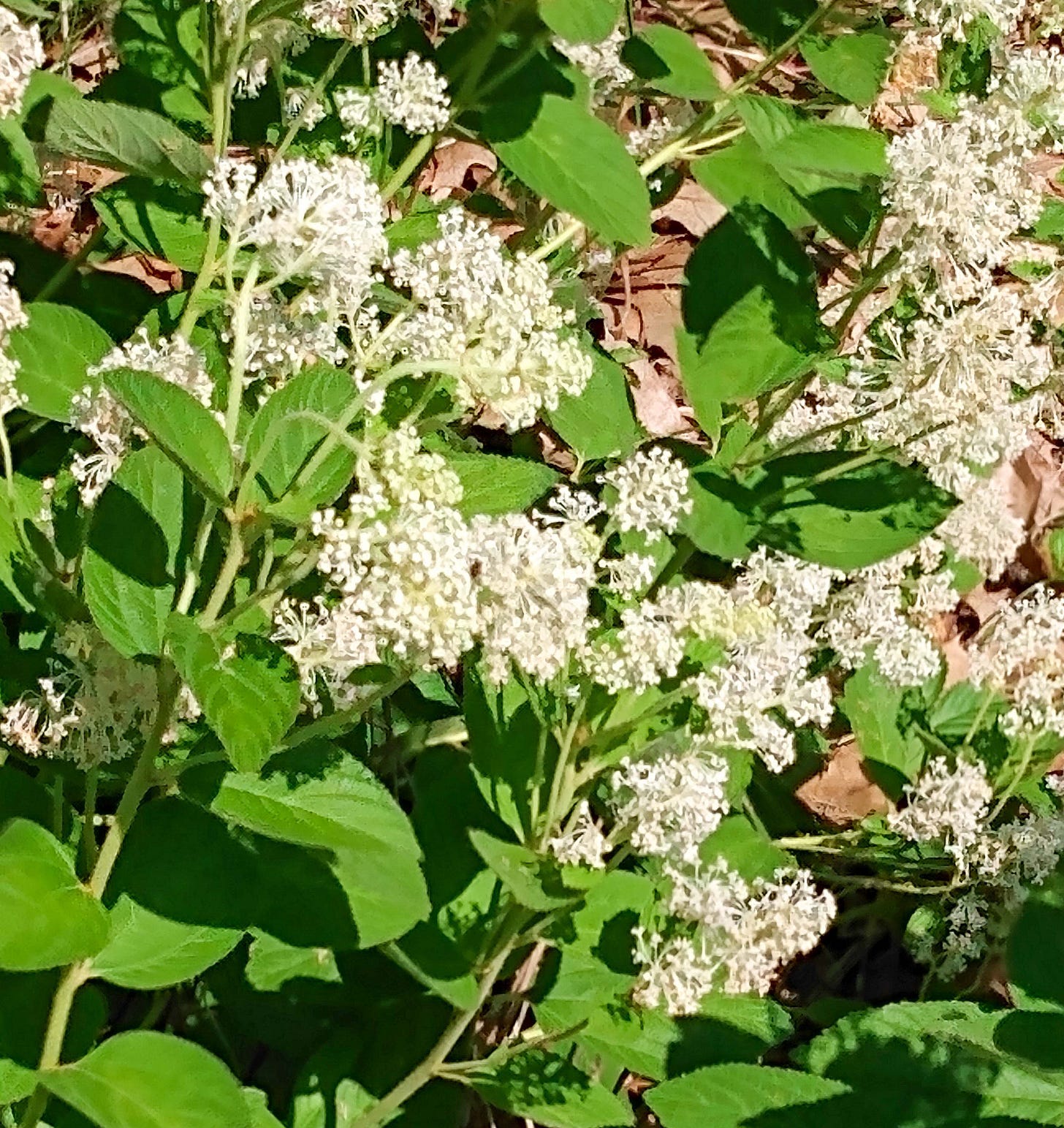
Sweet Pepperbush - Plethora alnifolia. Late summer white flowers delight pollinators, seeds feed birds in fall/winter. Enjoys moist, sandy soil. Tolerates full shade, clay soils, wet soil, salt spray. Larval host plant for several butterflies.
Witch Hazel - Hammamelis virginiana. Pruning will help if you don’t like its possibly 20 ft. Height. BLOOMS IN FALL, October/ December - an incredible boon to hungry pollinators. Tolerates clay. Feeds birds in winter.
Shrubby St. John’s Wort - Hypericum prolificum. Yellow flowers throughout summer are a joy to pollinators. Maximum height 5 ft., but can be pruned. Larval host plant to several butterflies.
Pussywillow - Salix discolor. Earliest flower of all our natives! Adorable fuzzy catkins give way to bright yellow bloom which is a welcome feast for winter-starved pollinators in early March. Prefers medium to wet soil, but can manage in drier situations. Larval host plant for several butterflies, too.
Semi-evergreen Baccharis halmifolia (Eastern Baccharis) is a great bet, particularly if you live where salt is common. This gorgeous shrub can reach 12 feet, but is easily pruned. It blooms in late summer, often holding blooms in October, making it a hit with pollinators. It is dioecious, meaning there are male and female plants; you will need both to obtain fertile seeds. If seeds are not what you’re looking for, you don’t have to worry about that. Native to the Atlantic coastal areas, it will grow rather happily almost anywhere.
Winterberry (Ilex verticillata) isn’t evergreen, but it is a stunning shrub in winter. Those glorious berries feed many a hungry bird. You will need both male and female plants to get the berries; they are sold under different species names. “Southern Gentleman” is obviously a male; you will only need one to achieve berries on every shrub in your yard.
Groundcovers
Good, low-growing native ground covers are always worth looking for to replace wood mulch with green mulch. Staring out at snow covered land, perhaps it’s time to consider ordering some of these to start underplanting all your trees and shrubs. Planted this spring, they are unlikely to bloom this year, but they will bloom reliably in early spring every year after.
Violets - You can buy these. Really, you can. Or you can do what most of us do, which is dig them out of the lawn and replant where they’re wanted. They’re a fabulous ground cover, growing in sun or shade, and mostly impervious to drought. They are also larval host plants for Fritillary Butterflies, so you’ll have many charming pollinators come summer.
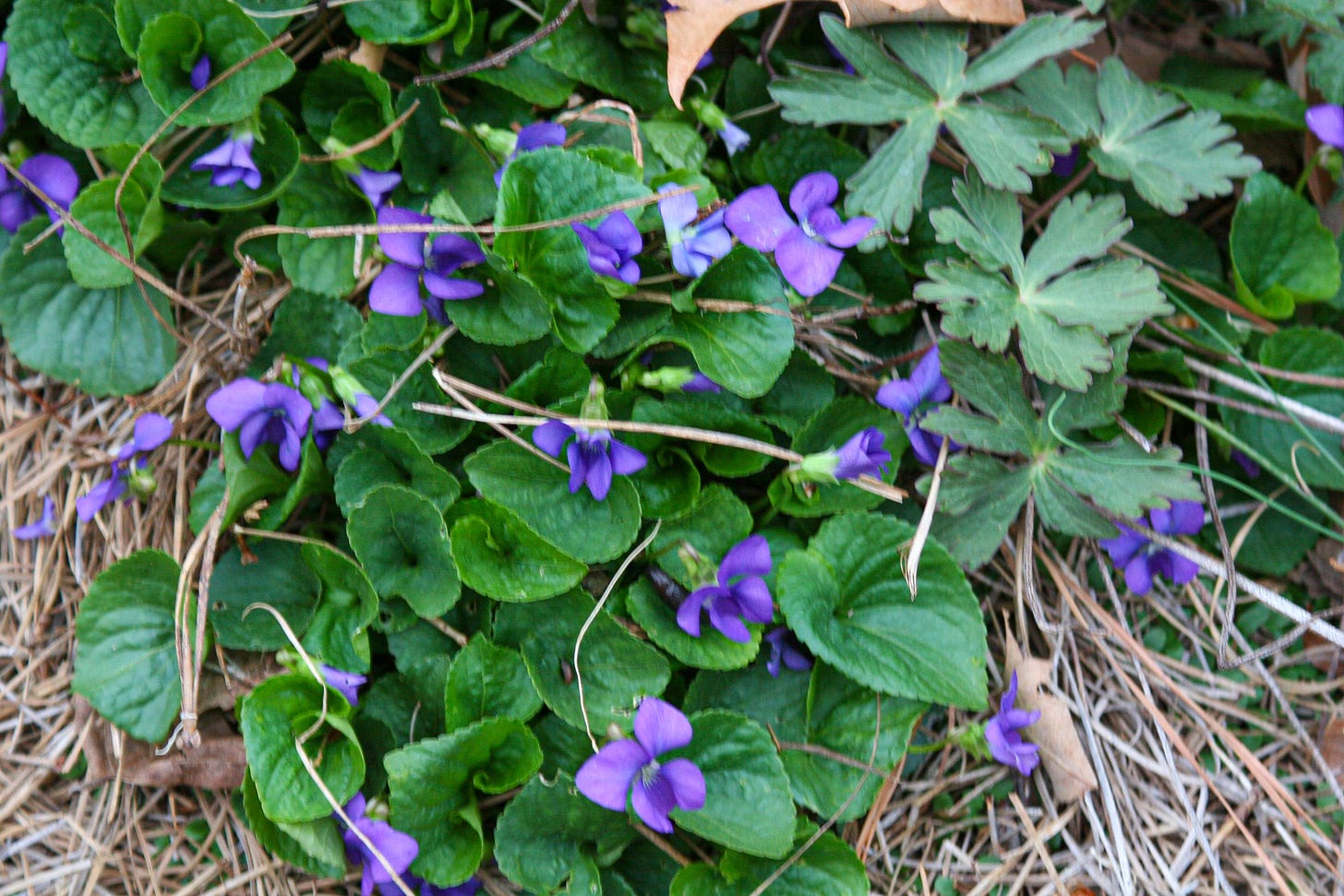
Creeping Phlox. There are several native creeping phloxes; if you have sun, you want Phlox subulata, if not, Phlox divaricata and Phlox stolonoifera are your dream plants. Growing only 6 - 8 inches high, these phloxes bloom quite early in spring and provide welcome habitat for tiny creatures all year round.
Geraniums. There are several varieties that may entice you. While their listed height may look tall, these plants flop with the best of them, providing good ground cover, green mulch, and a view of the taller plants nearby. Carolina Cranesbill (Geranium carolinium) and Spotted Cranesbill (Geranium maculatum) are adaptable and easily grown. Blooming in early spring, they compliment nearby bloomers such as Columbine.
Columbines. There are many cultivars, but the fully native Eastern Columbine (Aquilegia canadensis) is beloved of hummingbirds and are sure to attract many when in bloom.
Ferns. Ferns are reliable ground cover for shady areas. One, Christmas Fern, will even accept dry conditions. For shady, particularly damp and shady, areas, you can’t beat ferns for pure beauty and good value to wild creatures, who inhabit the ferny land beneath the fronds. Lightning bugs are fond of ferns for daytime dreaming.
Late Blooming Flowers
From late April through July there are many, many choices for pollinators. Come August, the pickings get slimmer in most yards. Look for:
Asters. The scientific name of these has changed (usually Symphyotrichum) but the plants are just as esteemed as ever. Look for New York Asters (Symphiotrichum novi-belgii) and other sun lovers; White Wood Asters (Eurybia divaricata) will bloom prodigiously even in nearly full shade. All bloom in late summer/early fall.
Goldenrods. Considered one of the most valuable plants in the native garden, there’s a Goldenrod for every situation. Most adore sun, but Blue Stemmed Goldenrod (Solidago caesia) and Zigzag Goldenrod (Solidago flexicaulis) prefer shadier locations; they will bloom if there’s even a minute or two of sun during the day, and will grow as nice ground covers even in deep shade. All are larval host plants and well worth growing.
Black Eyed Susans. This is the native flower of Maryland. Rudbeckia hirta is not a true perennial, it’s a biennial. However, it seeds out so freely and happily you’ll never know the difference! Beloved of all pollinators, it’s sure to bring color and joy to your garden. In far northern climates (zones 1 & 2), Susans do just fine growing as annuals (just let them go to seed!).
Joe Pye Weed. There are several varieties, all blooming in later summer and all a joy to pollinators. From Tall Joe Pye Weed (Eupatorium fistulosum) to Little Joe (Eupatorium dubium or Eutrochium dubium), there’s a Joe Pye that’s a show stopper for your yard. Pick one or several. You can’t go wrong, and pollinators - particularly butterflies - will be over the moon.
Deciduous Trees
Then, there’s the ever necessary deciduous trees. Oaks of all description are the best of the best for pollinators, acting, as they do, as larval host plants for more than 500 species of insects, including the rare Luna Moth. You can’t do better for nature than plant an oak. Go for it! Various Maples (NOT Norway Maple, an invasive) are great, too, and, for sheer variety and happiness of birds and pollinators, the Sumacs are truly great.
Sometimes… we may as well accept that climate change is here, it’s real, and it’s having its effect on all living creatures. Bees get confused in warm winters, flying about (using energy!) trying to find something to eat. Since our warmer winters encourage early flying of bees, who are “fooled” by the warm temperatures, we should occasionally - very occasionally! - look to non-natives to help them out. Our natives believe in colder winters and, while they might pop up a stem, are not ready to flower just because it’s warm in January. We must face it - sometimes we should, we really should, look to plants native to more southern climes than our own simply to provide these beleaguered gems something to eat in our newly warm winters.
Yaupon Holly (Ilex vomitoria) is native to the south eastern states. However, with temperatures growing ever warmer, it can grow happily far north of its truly native habitat (northern range is Virginia); it is known to survive well in zone 6. This is a lovely evergreen shrub that can easily replace those tired boxwoods and does a much better job of feeding birds in winter, too. If you like making tea, this is your shrub! It even has caffeine.

Camelias - except for two, Silky Camellia (Stewartia malacondendron) and Mountain Camellia (Stewartia ovata), are native to China and Japan. However, they are great shrubs for early flying bees, as they can bloom in December, January, February and more. Look for “Japonicas” (yes, from Japan) for bloom December - March; look for “Sasanquas” for late summer to early winter bloom. Together, they’ll feed a lot of hungry bees. They are shrubs, so there’s lots of bloom to go round. And yes, they’re evergreen. (To zone 6)
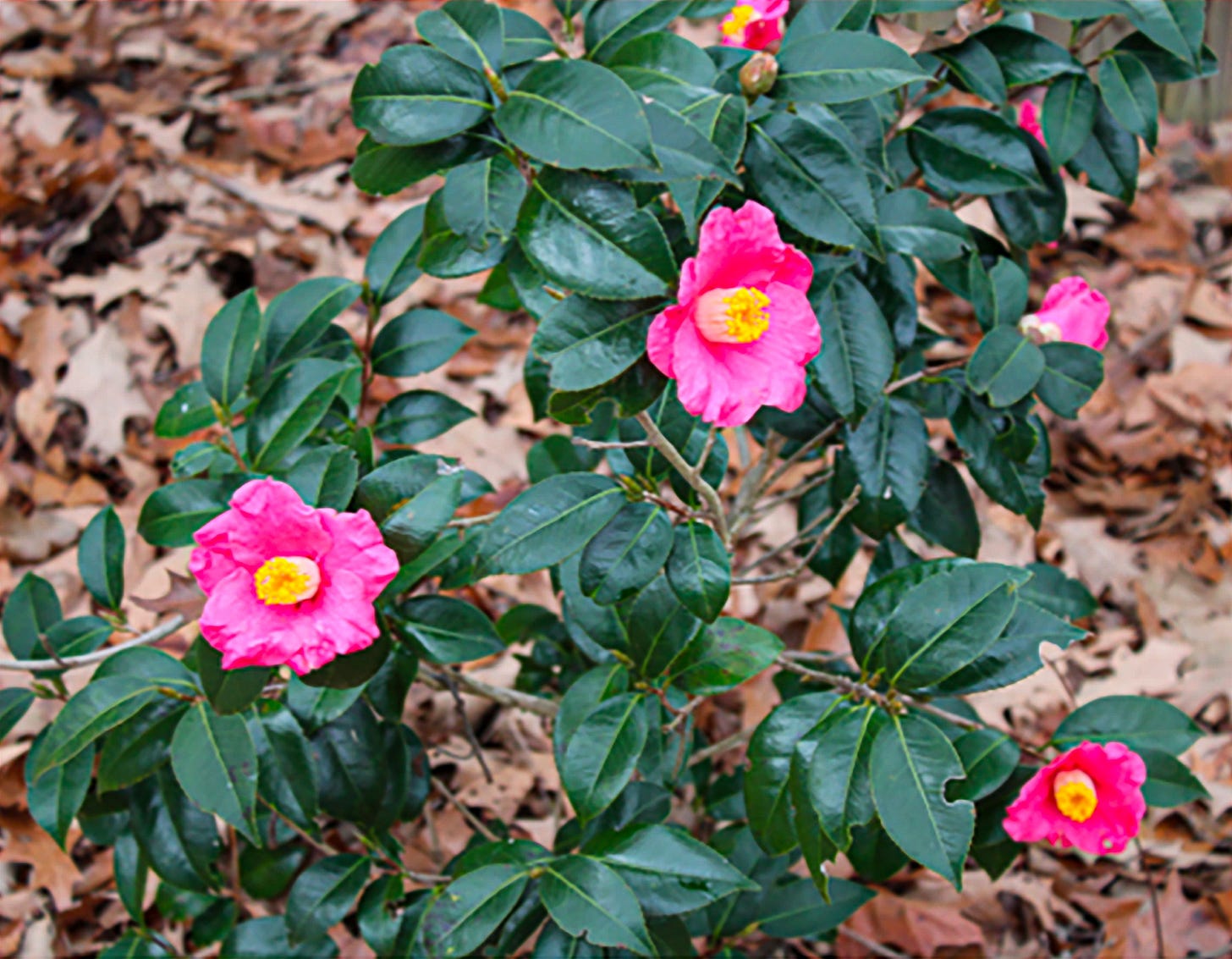
Happy Gardening! Stay warm and study the offerings online - it’s fun!

